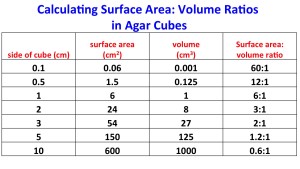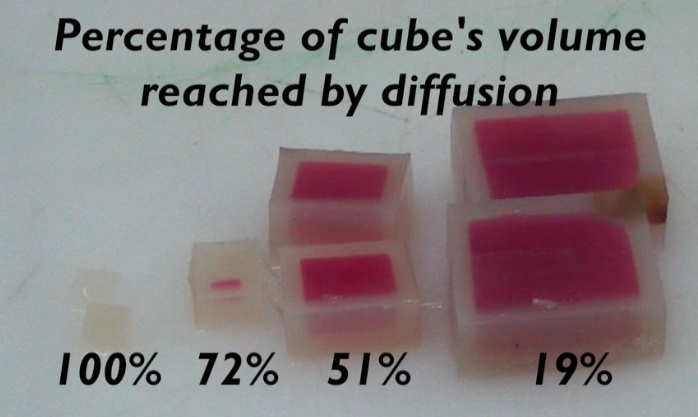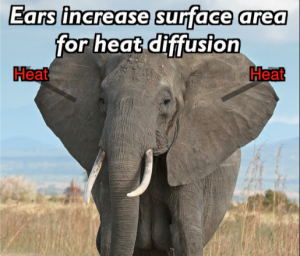How Do Large Animals Live With Low Volume Surface Area Ratio
- Looking for a student learning guide? It'southward in the master menu for your course. Use the "Courses" menu above.
- Click for the handout I use when I practice this lab with my students .
- If you've already watched the video, Click here , or curlicue down below the video to outset interacting.
1. Surface Surface area Volume Ratios and Life: The Basic Thought
For the virtually function, life occurs on a very small scale. Life is based on cells, and cells (with a few exceptions like egg cells) are minor. How small? A eukaryotic cell is typically about xxx micrometers in diameter. That's xxx millionths of a meter. A prokaryotic jail cell (the blazon of cell institute in bacteria) can exist anywhere from 300 times smaller to 5 times smaller. Why are cells, the basic units of life, so minor?
The answer lies in the relationship between a cell's surface surface area and its volume. Surface area is the amount of surface an object has.
- For a cube the formula for area is (length of a side)2 ten 6.
- For a sphere, the formula for surface area is iv Π r2
Volume is the amount of space inside something.
- For a cube the formula for volume is (length of a side)three.
- For a sphere, the formula is 4/three Π r3
The surface area to volume ratio is an object's surface surface area divided by its volume. Then, for a cube that'south one centimeter on a side,
- the surface area is 6cm2 (1cm x 1cm x 6),
- the volume is ane cmiii (1cm ten 1cm x 1cm), and
- the surface area to volume ratio is 6 units of surface: ane unit of book
As you can see from the formulas, surface area is foursquare office (side two x 6), while volume is a cubic function (side)3. As a result, equally the size of an object increases, its ratio of surface area to volume decreases. Conversely, every bit the size of an object decreases, its ratio of expanse to volume increases.

Study the tabular array above, which shows surface area, book, and the surface expanse:book ratio for a variety of cubes. Note that in a cube that'south 0.1cm on a side the surface area:volume ratio is 60:1. This ratio falls to 0.half dozen:i in a cube that's 10cm on a side.
This becomes fifty-fifty clearer in the chart below.

But how does this relate to the size of cells? Cells are constantly exchanging substances with their surroundings, and this exchange largely happens by diffusion of materials through the cell membrane, the outer boundary of a prison cell. Cells need to exist small then that they have enough surface for molecules to be able to lengthened in and out. On a much larger scale, y'all tin can see this in the motion-picture show below.

This picture is a still from the primary demonstration shown in the Surface Area, Volume, and Life video. The cubes are made of agar, a seaweed extract. The agar contains a pH indicator, and the cubes are fuchsia (dark pink) on the inside because their initial pH is basic. When placed in vinegar (an acid), the vinegar diffuses into the cubes. As the vinegar diffuses in, the pH indicator changes from fuchsia to white.
This is what the cubes wait like subsequently six minutes. Note that 100% of the smallest cube'southward volume has been reached by the vinegar, while but nineteen% of the largest video is reached by improvidence. The bones idea: minor size results in a high surface expanse to volume ratio, which enhances diffusion. And that's why cells are pocket-sized.

The same principle explains a diverseness of biological phenomena. Why practise elephants take big ears? Because elephants are huge, their bodies have a very low area to volume ratio. This makes it very difficult for heat to diffuse away from elephant's body. To compensate, elephants have evolved huge, flat ears. The ears, being flat, increase the elephant's surface expanse, while barely increasing the volume. Blood in the ears can release heat to the environment.
Flatness as an adaptation also explains why flatworms can survive without whatsoever specialized system for distributing oxygen or carbon dioxide throughout their bodies. Because they're flat, they have a very loftier area to volume ratio. This allows oxygen to lengthened from water directly to their trunk cells, and for carbon dioxide to lengthened from their trunk cells back out to the surrounding surroundings.

Reducing the surface expanse to volume ratio can also be an adaptive strategy. Think well-nigh marine mammals. None of them are very minor (the size of mice or fifty-fifty rats). The smallest marine mammals are otters, and it's no coincidence that most marine mammals are relatively large (think of walruses, dolphins, manatees, etc.). I marine mammal, the blue whale, is the largest fauna always to accept evolved. Why are marine mammals large? Information technology'south instructive to compare marine mammals with elephants. Whereas elephants evolved huge ears as a way to enhance heat diffusion by increasing their surface expanse to volume ratio, marine mammals have evolved large size every bit a way of decreasing their surface surface area to book ratio, equally a fashion of decreasing heat loss. Wait again at effigy three in a higher place. The big cube, with its low surface area to volume ratio, has relatively little diffusion happening over time. And in terms of heat exchange, that'south advantageous for mammals living in absurd ocean h2o. In other words, but by being large, marine mammals were able to evolve a strategy that enabled them to diminish rut loss.
ii. Checking Agreement
3. Interactive Reading: Applying the surface area to volume ratio.
Adjacent steps
-
- Introduction to Cells (next tutorial in this series)
- Cell Structure and Role Primary Carte du jour
Source: https://learn-biology.com/surface-area-volume-and-life/
Posted by: sotogreped.blogspot.com

0 Response to "How Do Large Animals Live With Low Volume Surface Area Ratio"
Post a Comment